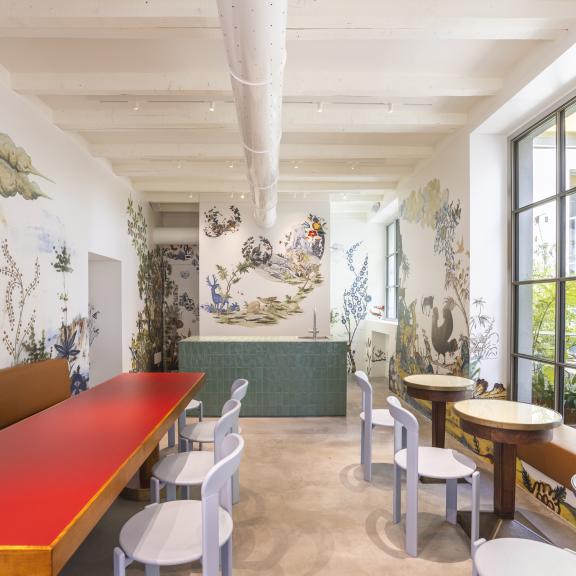Consider mental health and wellbeing in your practice
The interior design industry can be a stressful environment. We asked expert Kaye Preston about potential mental health issues and how designers can care for themselves and their employees.

High expectations, long hours and ever-present deadlines all make interior design a demanding profession – and one that can take a toll on individuals’ wellbeing and mental health. Whether you work alone in your own practice, or are employed, these factors and others both professional and personal can weigh heavily.
In the past, mental health was frequently a taboo subject, but today there is growing openness about discussing it, as well as addressing the causes of depression, stress and anxiety in the workplace, and paying attention to our own wellbeing and that of the people we might employ.
We talked to BIID Member and interior designer Kaye Preston, founder of Designers Mind about the particular issues designers face and the strategies that can promote good mental health.

Could you tell us a little about yourself and what led you to found Designers Mind?
I’m an interior designer with over 15 years of experience, a WELL AP (a health and wellbeing credential that denotes expertise in the WELL building standard) and holistic health coach. I’m equally passionate about designing for wellbeing and the wellbeing of designers. I’ve also launched my own health coaching business empowering designers to develop practices that enhance their wellbeing so they can live more sustainable lifestyles and thrive in all areas of their lives.
My own personal experience with burnout, depression and anxiety and the knowledge that many other colleagues also struggled at some point with their mental health led me to found Designers Mind. I want to champion change in the industry, shifting mindsets around wellbeing while raising awareness that by making time for our physical health we are also protecting our mental health.
What particular pressures does practising as an interior designer bring that can impact mental health?
The design industry is a stressful environment often marked by designers who work incredibly long hours to meet tight deadlines. The pressure to be always ‘on’ and creative is high, and expectations from leadership, clients, and personal ambitions feed into the daily stress designers are challenged with. When working under this pressure, often the simplest of wellbeing practices get overlooked.
When we don’t prioritise our health, it can be even more challenging to deal with stress and this makes us less resilient.
What strategies might designers consider if they are experiencing challenges to their wellbeing and mental health?
Firstly, it’s important that designers do recognise if they’re experiencing challenges. This will look different for everyone, and this isn’t an exhaustive list, but some signs that they may be struggling with their mental health are: feeling more tired, experiencing frequent headaches, digestive problems, changes in appetite, back or joint pain, mood changes, tearfulness, loss of motivation, feeling more sensitive than usual, withdrawal and feeling irritable. Building self-awareness and truly understanding their needs is an important step for their overall wellbeing.
Some further strategies might include getting back to basics with their health, prioritising sleep, eating well and drinking plenty of water, movement and exercise, taking breaks and getting more rest, learning how to set boundaries, communicating their needs to those around them, and having daily practices and routines that allow them to switch off from tech.
Reaching out and getting support is hugely important for everyone if they think they may be struggling, whether that’s via colleagues, friends and family or a professional.
How can sharing experiences with fellow professional designers help?
Sharing experiences can help us to realise that we’re not alone and opens up the conversation to get help when needed.
Sharing our stories helps to raise awareness and break the stigma around mental health while highlighting the importance of incorporating wellbeing practices into our days. We can then start to make changes in the way we work so we become a more proactive industry with regard to our health and wellbeing.
What can designers who employ others do to safeguard employees’ mental health?
It’s important to create an environment and workplace culture where the health and wellbeing of employees is valued and considered rather than being an afterthought or reaction to a challenge.
A culture of health integrates employees’ mental health and wellbeing into operations and goals and requires engagement from all levels of an organisation, creating a culture of openness where employees feel they can be honest with leadership about any struggles they may be facing.
There are steps that any employer can take to help address wellbeing in the workplace and to make sure that people feel supported through programmes, policies, benefits and office design. These steps could include:
- Mental health first aid training; HR staff (or a nominated person) having at least basic training to understand mental health issues.
- Offering a health benefits plan to all eligible employees that includes not only physical health but mental health services as well and using the support available through employee assistance programmes (EAP).
- having a mentoring, training and performance review policy to support staff progression.
- Consider coaching to help employees identify and reach their goals; and addressing work/life balance issues.
And what are the best strategies if you’re working solo in your interior design practice?
When you’re working solo, one of the biggest challenges can be that you have to wear many hats in your business making it even harder to switch off. (I say this from experience being a designer and entrepreneur.)
Ensuring you’re getting enough rest is crucial. Set boundaries with yourself around switching off in the evenings. Carve out focus time during your day (at a time when your energy is high), turning off all notifications. Manage expectations with your clients and ensure you limit time on email so you’re not responding late into the evenings.
I’ve discovered that a very important factor and strategy of time management is energy management. Making time to take care of your wellbeing will give you more energy. This will in turn give you greater productivity, focus and creativity throughout the day so you can get more done. It may feel counterintuitive to take time out for your health but it will allow you to truly optimise your time.
Something we could all benefit from is being more proactive with our mental health and wellbeing by really looking at the way we’re working. Making time for our wellbeing will enable us to truly thrive, not only in our work, but all areas of our lives.
Useful Resources
If you are struggling with your mental health, you can find more information via the NHS Website. You can also visit your GP who can help you access the support you need.
If you need immediate help you can also contact Samaritans or Mind.
We asked Naomi Astley Clarke: What makes the perfect client?
Iris Ceramica Group Presents: Design Without Limits with Design Your Slab (DYS)
Shape the BIID's future by standing for the Council of Directors at this years AGM
The BIID are delighted to welcome Swatchbox back as a Platinum Partner
The BIID are delighted to announce the launch of our Online Drop In Coaching Sessions
In celebration of our 60th year, we look back at 60 years of interior design





